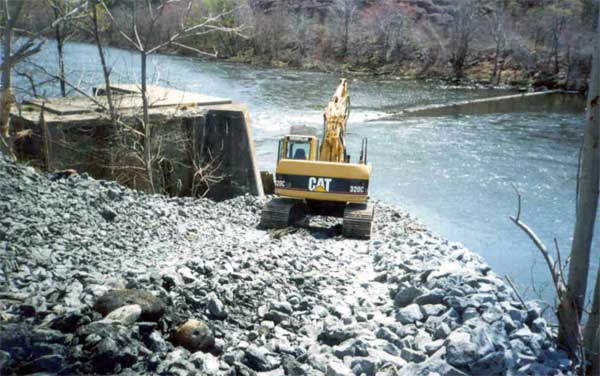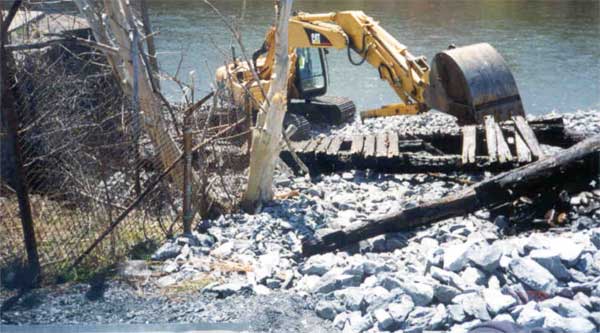 |
| Palmerton Dam partially removed |
| |
 |
| Cribbing structure removed from Palmerton Dam |
| |
|
I was recently viewing a presentation about the planned removal of four dams on the Klamath River. It jogged my memory.
Way back in 2006, I removed a dam — it was one of my fondest accomplishments from a safety and environmental point of view and an opportunity to leave my mark on the planet — even though it was in not what I created, but in what was no longer there — a low head dam that was no longer of any value but was a constant hazard for swimmers, anglers, kayakers and rafters.
In the early 1900s, the New Jersey Zinc Company needed a location to smelt the ore that they mined in New Jersey. The site had to have rail access, water, and available land. The found that land near the Lehigh Gap in Pennsylvania—the break in the Appalachian Mountains where the Lehigh River passed through—was perfect.
There NJZ founded Palmerton, named after the president of the company. This developed into a socially conscious company town—but that's another story. What is central to this article is that the company needed power to smelt the zinc and there were no significant power lines in the area—and wouldn't be until the 1950s.
So, NJZ built an electrical generating plant. As the head of the adjacent river was too low to economically generate electricity by hydropower, they opted to use the available coal, which was plentiful in the area, as the source of fuel.
This conventional power plant relied on a water-cooled condenser to condense the steam leaving the turbines, and arranged to take the water from the Lehigh River by installing a low head dam. The dam was of a cribbing design made up of pinned-together logs filled with large stones.
All went as planned until PP&L brought sufficient power to the NJZ plant that the power plant was no longer required. It shut down but the dam remained.
|
I was a whitewater guide on the Lehigh River, associated with the Wildlands Conservancy, and a journalist. While participating in a Wildlands Conservancy trip down the trip leader Jerry McAward and I passed by the Palmerton Dam and carefully routed boats around a small breach in the dam.
Jerry and I got to talking about how dangerous the dam was and we wondered if it could be removed. So, later on, I contacted members of several groups involved in ecology, paddling, fishing and government and organized a pow wow.
Everyone agreed that the dam should go, but who owned the dam? I made some calls, and eventually contacted the president of Horsehead Industries, the conglomerate that had taken over the New Jersey Zinc Company.
I asked the president if Horsehead owned the dam. He said that he would check and two weeks later he said that they owned it. Next I asked, "Would be OK if the dam was removed?"
He responded, "Give me a good reason why I would want the dam removed."
I answered, "Sometime in the future, someone may die in the hydraulic of the dam—and Horsehead would be responsible."
"When can you remove the dam?" he responded.
So, our group of stakeholders rejoined, got support from the Dept. of Environmental Protection, and found budget money for dam removal, and we had the State draw up the paperwork and plans. Two years later, the dam was gone.
And so, until I left Pennsylvania, I enjoyed taking paddlers on a wonderful and safe trip down the Lehigh River and through the Lehigh Gap—without a dam.
~Al Zagofsky |
